Predictions & Data for this entry
| Model: abj | climate: ME | migrate: Mo | phylum: |
| COMPLETE = 3.5 | ecozone: MN | food: bjPz, jiCi, jiCvf | class: |
| MRE = 0.187 | habitat: 0jMp, jiMd | gender: D | order: |
| SMSE = 0.060 | embryo: Mp | reprod: O | family: |
Zero-variate data
| Data | Observed | Predicted | (RE) | Unit | Description | Reference |
|---|---|---|---|---|---|---|
| ab | 42 | 58.5 | (0.3929) | d | age at birth | KentDros2016 |
| aj | 161 | 199.6 | (0.2396) | d | age at metamorphis | KentDros2016 |
| ap | 404 | 360.3 | (0.1081) | d | age at puberty | KentDros2016 |
| am | 2555 | 2555 | (0.0001331) | d | life span | Crai1982 |
| L0 | 1.67 | 1.665 | (0.003118) | mm | egg diameter | DahlNahr2017 |
| Lj | 3.4 | 3.436 | (0.01048) | cm | length at metamorphosis | KentDros2016 |
| Lp | 10 | 9.442 | (0.05576) | cm | total length at puberty | NahrVarp2014 |
| Li | 30.5 | 30.55 | (0.001774) | cm | ultimate total length | NahrVarp2014 |
| Ww0 | 0.0022 | 0.001597 | (0.2742) | g | egg wet weight | Nahr2017 |
| Wwj | 0.2877 | 0.2334 | (0.1888) | g | wet weight at metamorphosis | WalkPaul2011 |
| Wwp | 4.6 | 4.845 | (0.05323) | g | wet weight at puberty | NahrVarp2014 |
| Wwi | 157 | 164.2 | (0.04556) | g | ultimate wet weight | NahrVarp2014 |
| Ni | 3.653e+04 | 2.224e+04 | (0.3912) | # | fecundity at 21 cm | NahrVarp2014 |
Uni- and bivariate data
| Data | Figure | Independent variable | Dependent variable | (RE) | Reference |
|---|---|---|---|---|---|
| LW | 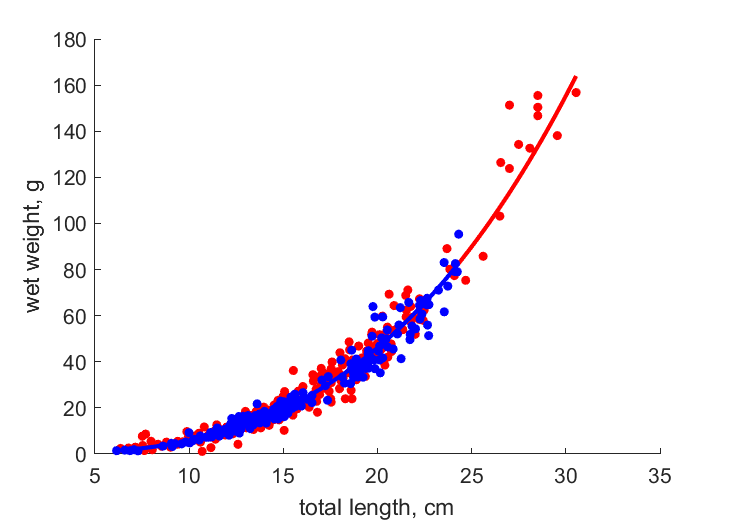  | total length | wet weight | (0.131) | NahrVarp2014 |
| LW1 |   | total length | wet weight | (0.1075) | FeyWesl2017 |
| tL8 | 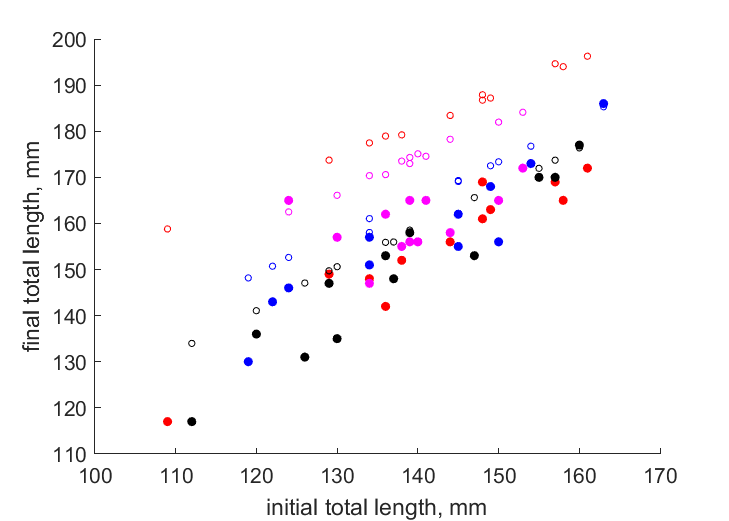 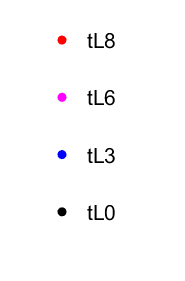 | initial total length | final total length | (0.18) | KunzFric2016 |
| tL6 |   | initial total length | final total length | (0.08655) | KunzFric2016 |
| tL3 |   | initial total length | final total length | (0.05289) | KunzFric2016 |
| tL0 |   | initial total length | final total length | (0.04833) | KunzFric2016 |
| tW8 | 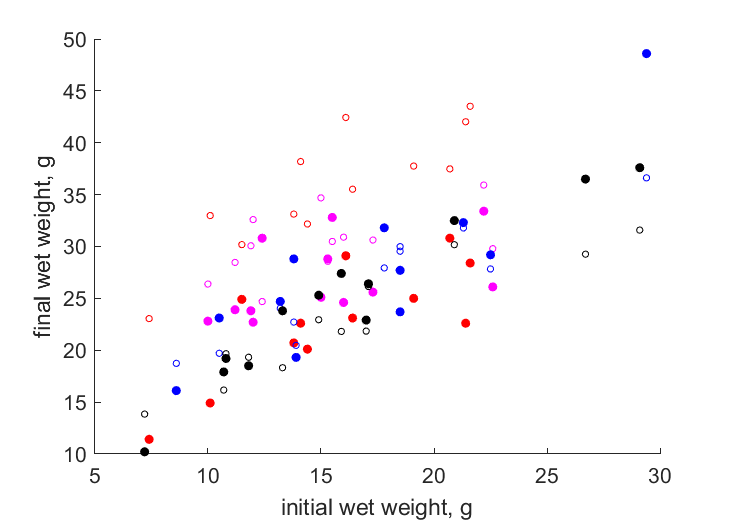 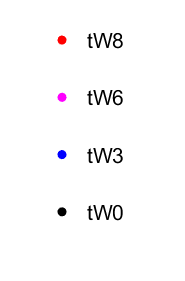 | initial wet weight | final wet weight | (0.5659) | KunzFric2016 |
| tW6 |   | initial wet weight | final wet weight | (0.1875) | KunzFric2016 |
| tW3 |   | initial wet weight | final wet weight | (0.1304) | KunzFric2016 |
| tW0 |   | initial wet weight | final wet weight | (0.1241) | KunzFric2016 |
| LJO8 |  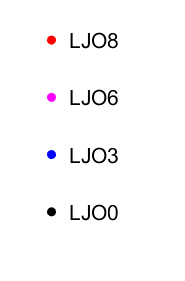 | final total length | respiration | (0.2334) | KunzFric2016 |
| LJO6 |   | final total length | respiration | (0.1738) | KunzFric2016 |
| LJO3 |   | final total length | respiration | (0.1626) | KunzFric2016 |
| LJO0 |   | final total length | respiration | (0.3842) | KunzFric2016 |
| LJX8 | 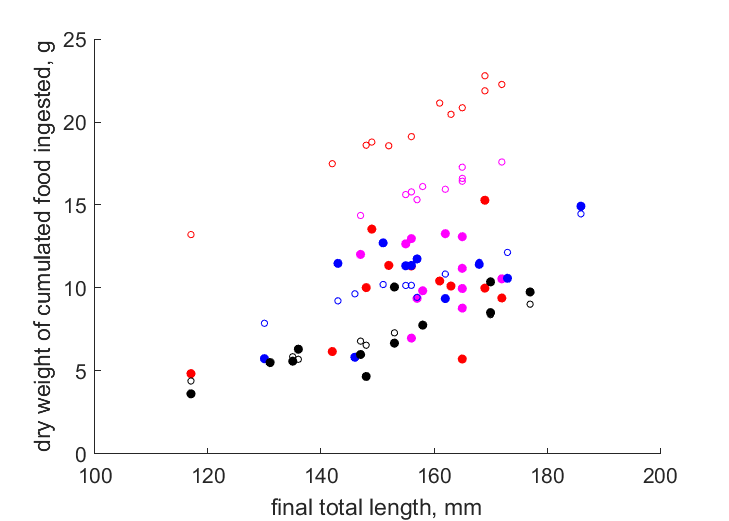 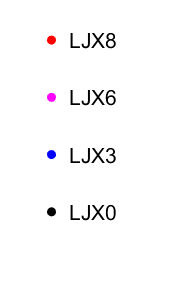 | final total length | dry weight of cumulated food ingested | (0.9902) | KunzFric2016 |
| LJX6 |   | final total length | dry weight of cumulated food ingested | (0.4792) | KunzFric2016 |
| LJX3 |   | final total length | dry weight of cumulated food ingested | (0.1635) | KunzFric2016 |
| LJX0 |   | final total length | dry weight of cumulated food ingested | (0.1256) | KunzFric2016 |
| LW8 | 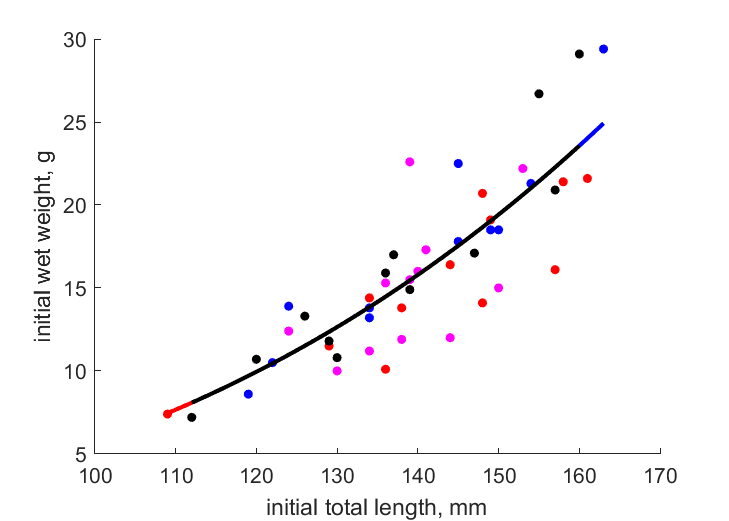 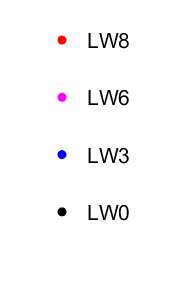 | initial total length | initial wet weight | (0.1313) | KunzFric2016 |
| LW6 |   | initial total length | initial wet weight | (0.1683) | KunzFric2016 |
| LW3 |   | initial total length | initial wet weight | (0.08616) | KunzFric2016 |
| LW0 |   | initial total length | initial wet weight | (0.1195) | KunzFric2016 |
| LN |  | total length | egg number | (0.4877) | NahrVarp2014 |
| TJO | 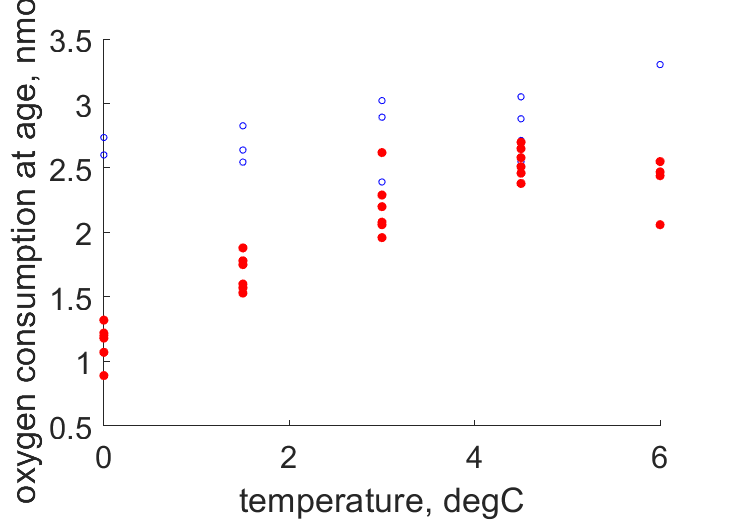 | temperature | oxygen consumption at age | (0.4504) | DahlNahr2017 |
| tL | 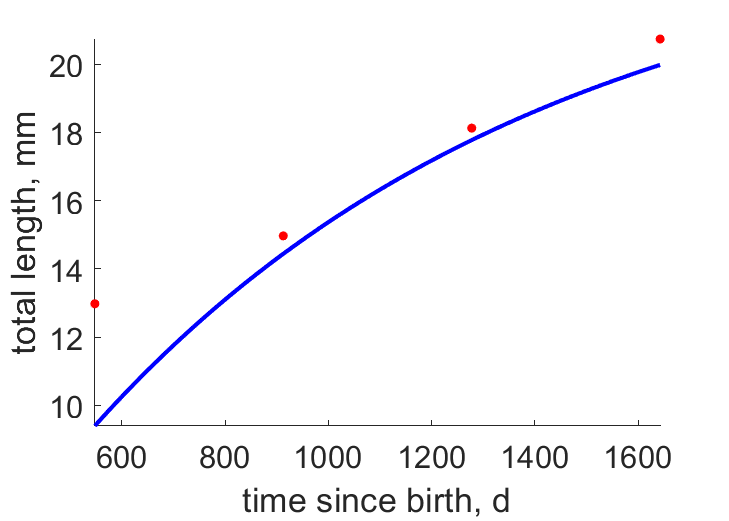 | time since birth | total length | (0.07802) | NahrVarp2014 |
| tL2 |  | time since hatch | standard length | (0.2446) | BoucMoll2016 |
| tLe | 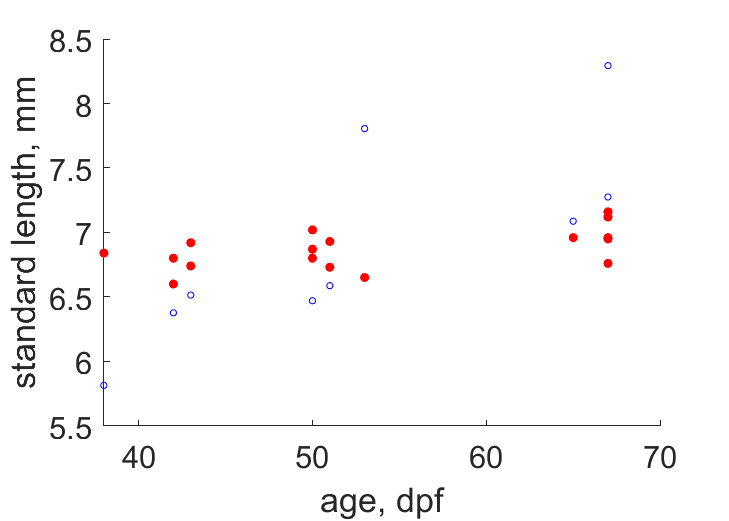 | age | standard length | (0.06674) | DahlNahr2017 |
| tW1 |  | time | wet weight | (0.07807) | HopTonn1997 |
| tW2 | 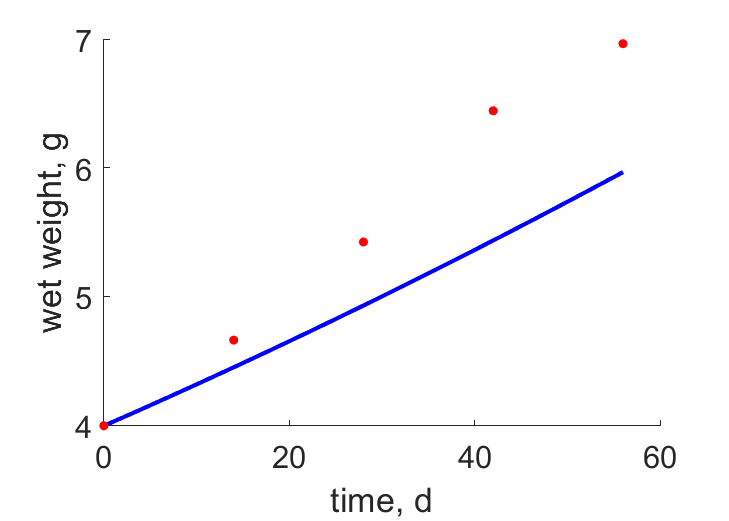 | time | wet weight | (0.09882) | HopTonn1997 |
| tWwe | 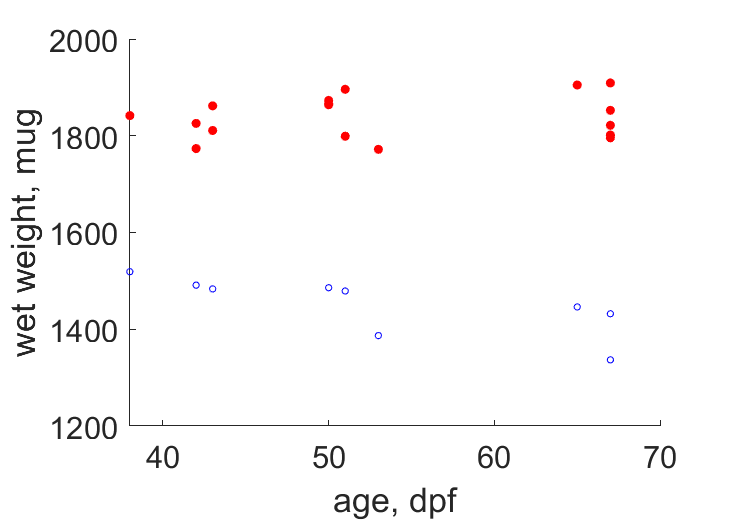 | age | wet weight | (0.2076) | DahlNahr2017 |
Pseudo-data at Tref = 20°C
| Data | Generalised animal | Boreogadus saida | Unit | Description |
|---|---|---|---|---|
| v | 0.02 | 0.01631 | cm/d | energy conductance |
| p_M | 18 | 477 | J/d.cm^3 | vol-spec som maint |
| k_J | 0.002 | 0.002 | 1/d | maturity maint rate coefficient |
| k | 0.3 | 0.02201 | - | maintenance ratio |
| kap | 0.8 | 0.5398 | - | allocation fraction to soma |
| kap_G | 0.8 | 0.7972 | - | growth efficiency |
| kap_R | 0.95 | 0.95 | - | reproduction efficiency |
Discussion
- KunzFric2016: energy content of food 20.4 kJ/g dry weight (pers comm company making the food)
- We included only laboratory data and field data from individuals taken around Svalbard, with the exception of Lh, Lb and L-W for juveniles.
- Some gonadal mass may be retained after spawning (not taken into consideration here).
- mod_2: error in temperature parameters of mod_1 are corrected, also an error in the input to several calls to tempcorr function in predict are fixed. Parameters are re-estimated.
Facts
- Most ubiquitous Arctic fish, found in diverse arctic and subarctic habitats ranging from brackish to fully marine waters, from coastal to offshore waters and from surface waters to great depths (Ref: BoucMoll2016)
- Adults tend to avoid high temperatures (Ref: GrahHop1995)
- Loses about half the body mass as eggs. Energy is taken mostly from liver but also muscle. (Ref: HopGrah1995b)
- Larvae prey on: C. hyperboreus and C. glacialis (Ref: BoucMoll2016)
- Feeds on amphipods, copepods, adults from the Arctic domain feed mostly on Themisto libellula (large Arctic amphipod) (Ref: HopGjos2013, NahrVarp2014)
- Has the largest and fewest eggs of all Gadidaes. Distribution associated with ice; especially characteristic of regisions between pack ice and drift ice. Main consumer of plankton in the Arctic seas. (Ref: Andr1954)
Acknowledgment
- The creation of this entry was supported throughPOLARISATION - Polar cod, lipid metabolism and disruption by polycyclicaromatic hydrocarbons - (01/2012-03/2016) NFR FRIPRO/fellesloftet 214184.
Bibliography